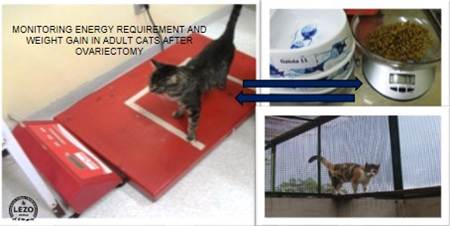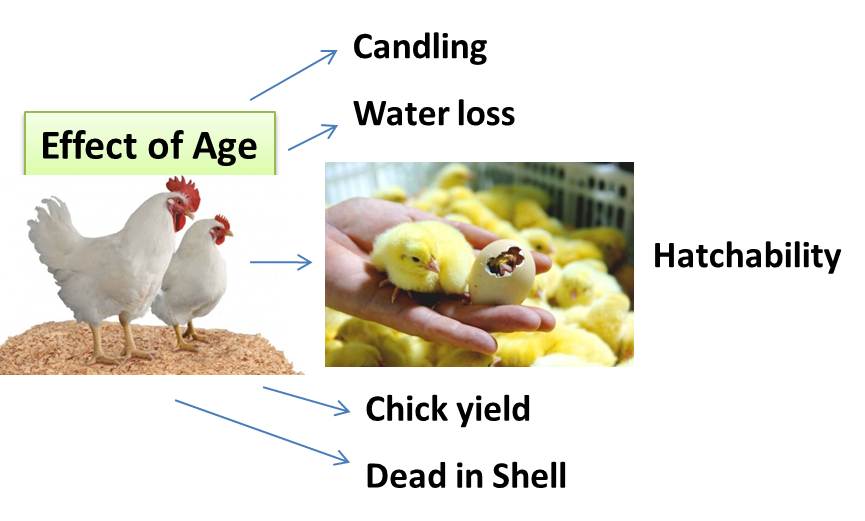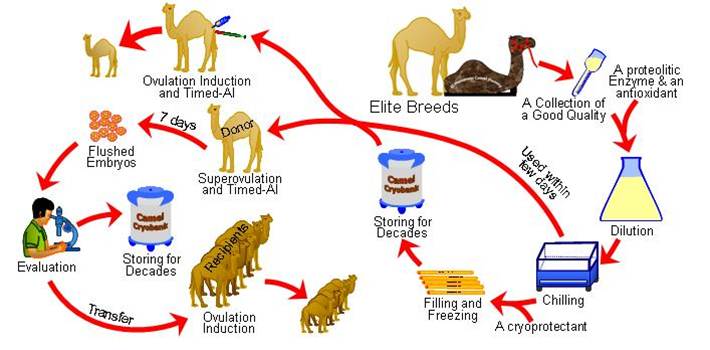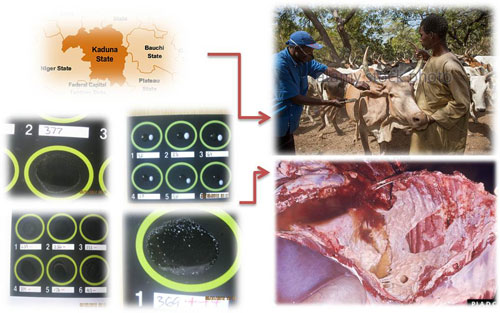Previous issue | Next issue | Archive
Volume 7 (2); June 25, 2017 [Booklet]
Monitoring Energy Requirement and Weight Gain in Adult Cats after Ovariectomy.
Machado GS, Pezzali JG, Schoreder B, Ongaratto C, Villela LM and Trevizan L.
World Vet. J. 7(2): 36-39, 2017; pii:S232245681700006-7
DOI: http://dx.doi.org/10.5455/wvj.20170492
ABSTRACT
To evaluate the effect of ovariectomy on food intake and body weight gain in adult cats fed according to their maintenance energy requirement (MER) and cats fed 1.5 times their MER. Eleven crossbreed adult female cats were monitored and weighed daily before undergoing ovariectomy, and their MER was determined once a stable body weight had been achieved. The ovariectomies were performed afterwards the cats were divided into two groups: group 1, composed of 6 cats, receiving the amount of food corresponding to their MER; and group 2, composed of 5 cats, fed 1.5 times their MER. No significant differences were found regarding food intake, alometric factor (kcal/kg0.67) and Metabolizable Energy (ME) intake (kcal/day) (P > 0.05) for cats in group 1. However, these cats gained weight over the 30 days after ovariectomy (P < 0.05). Cats in group 2 presented significant difference for food intake, alometric factor, ME intake (kcal/day) and body weight (P < 0.05). Ovariectomy had influenced the MER. Spayed cats that continued receiving the same energy intake before ovariectomy had gained weight, showing that the MER for cats had decreased after the procedure. Cats in group 2 had gained more weight than those in group 1. In order to keep spayed cats within the optimal body weight, it is necessary to monitor their feed intake, considering that the MER changes after ovariectomy, and female cats tend to overeat and gain weight, which may lead to being overweight or obesity.
Key words: Spayed, Obesity, Food intake, Cat nutrition
[Full text-PDF] [XML] [Import into EndNote] [Citations on Google Scholar]
Effect of Broiler Breeders Age on Hatchability, Candling, Water loss, Chick yield and Dead in Shell.
Jabbar A and Ditta YA (2017).
World Vet. J. 7(2): 40-46, 2017; pii:S232245681700007-7
DOI: http://dx.doi.org/10.5455/wvj.20170493
ABSTRACT
Water loss, chick yield and DIS analysis are all important factors in quality investigation of both the chick and hatchery performance. The age of breeders affect the hatchability, egg weight, chick weight water loss, Candling and DIS. In this experiment the broiler breeder were divided into three groups on the basis of age, young (24-30 weeks), prime (31-50 weeks) and old (51+ weeks) to investigate the effects of hatchability , egg weight, chick weight , Water loss, chick yield and DIS along mal-position and mal-formations. Hatchability (81.98±1.1, 88.44±1.6, 79.60±1.6), candling (10.25±1.25, 6.44±0.88, 10.73±1.25), DIS (7.7±0.4, 5.1±0.6, 9.6±0.6), water loss (11.29±0.11, 11.77±0.16, 12.13±0.16), egg weight (57.2±0.5, 64.2±0.7, 70.5±0.7), chick weight (39.4±0.3, 43.9±0.5, 48.15±0.5) were significantly (P< 0.001) different for young, prime and old groups respectively. For crack eggs (0.5 ±0.12, 0.5±0.17, 1.1±0.17) and contaminated eggs (0.63 ±0.09, 0.50±0.12, 1.31±0.12) young and prime were significantly (P< 0.0001) better then old. Young, prime and old were significantly different for early embryonic mortality (3.07±0.3, 3.46±0.2, 4.55±0.3) respectively, while for mid (1.04±0.13, 0.53±0.09, 1.0±0.13) and late embryonic mortality (3.77±0.4, 2.58±0.2, 3.28±0.4) prime was significantly better than young and old. Range of hatch window was 20-24 hours for prime and old while 20-22 hours for young. Mal-Position and Mal-Formation were significantly identical for all three groups. Mal-Position and Mal-Formation were 1.5% and 0.5% for total eggs set respectively.
Key words: Broiler, Breeders, Water loss, Chick yield, DIS, Mal-Formation/Mal-Position
[Full text-PDF] [XML] [Import into EndNote] [Citations on Google Scholar]
Prospects of Improving Semen Collection and Preservation from Elite Dromedary Camel Breeds.
El-Hassanein EE.
World Vet. J. 7(2): 47-64, 2017; pii:S232245681700008-7
DOI: http://dx.doi.org/10.5455/wvj.20170494
ABSTRACT
Low reproductive performance is one of the most important factors affecting camel productivity. The genetic improvement of dromedary camels is still less progressed compared with other productive farm animals. In order to improve productive and reproductive performance of camels, monitoring and increasing efficient selection strategies in concurrent with developing assisted reproductive technologies and establishing a semen bank for elite camel breeds is urgently needed. To this date, semen preservation and its related techniques in dromedary camels has been slow due to the continual preference of natural breeding with elite males, the difficulty of semen collection, the highly viscous nature of camel semen and the low sperm resilience, unable to withstand processing for preservation. The present article is aimed in surveying of the fundamental challenges of semen collection, processing and preservation from dromedary camels. Developing a collection process, improving the rheological characteristics of delivered semen, modification of extenders and optimizations of the preservation protocols have also been discussed.
Key words: Breeding management, Electroejaculation, Camel-dummy, Semen viscosity, Processing, Chilling, Freezing.
[Full text-PDF] [XML] [Import into EndNote] [Citations on Google Scholar]
Sero-Prevalence of Contagious Bovine Pleuropneumonia in Three Senatorial District of Kaduna State, Nigeria Using Latex Agglutination Test.
Billy I La'ah, Balami Arhyel G, Sackey Anthony KB, Tekdek Lazarus B, Sa'idu Shehu NA and Okaiyeto Solomon O.
World Vet. J. 7(2): 65-73, 2017; pii:S232245681700009-7
DOI: http://dx.doi.org/10.5455/wvj.20170495
ABSTRACT
A study was conducted to determine the sero-prevalence of Contagious Bovine Pleuropneumonia (CBPP) in cattle in 3 senatorial districts of Kaduna State, using Latex Agglutination Test (BoviLAT PA 6223). One Local Government Area (LGA) from each senatorial district was randomly selected for this study thus; Ikara (Northern), Chikun (Central) and Kauru (Southern). A total of 300 blood samples were each collected from the selected LGAs in each senatorial district using simple random sampling without replacement technique. An overall sero-prevalence of 26.0% (234/900) was recorded, with Kauru having a higher sero-prevalence of 46.0% (138/300), followed by Ikara (17.0%) (51/300) and Chikun (15.0%) (45/300) LGAs. The sero-prevalence was highest (30%) in the age group of >6 years old and lowest (19.3%) in the age group <1-3 years old (P=0.0027). Based on sex of the cattle, there was no statistical significant association (P=0.1424) in the sero-prevalence of CBPP between the female (27.1%) and the male (21.9%) cattle. Though the sero-prevalence showed some degree of variation, there was no statistical significant difference (P=0.0572) in infection among Sokoto Gudali (57.1%), Red Bororo (50%) and White Fulani (25.3%) breeds of cattle. The study revealed the sero-prevalence of CBPP in cattle in the study area. Although BoviLAT Latex Agglutination is not capable of differentiating between antibodies from vaccinated animals and those of natural infection, it however provides, a fast and easy to perform diagnostic technique in the field, and therefore, good for early detection of cattle with CBPP.
Keywords: Chikun, Ikara, Kauru, Latex Agglutination, Mycoplasma mycoides, Sero-prevalence.
[Full text-PDF] [XML] [Import into RIS]
Previous issue | Next issue | Archive

This work is licensed under a Creative Commons Attribution-NonCommercial 4.0 International License.








